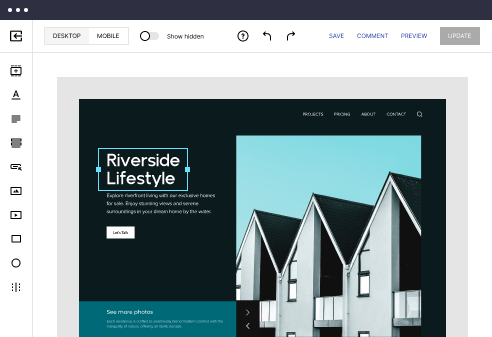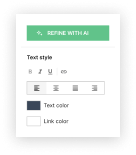
HTML page template for cloud computing companies
Use TemplateAbout template
Give your cloud computing companies a boost with our professional landing page templates. Ready to turn visitors into customers?
Recommended templates
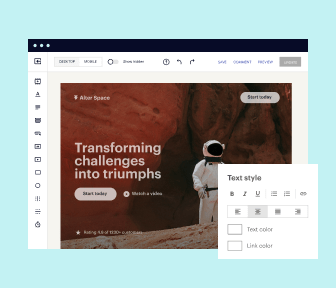
Easy to build without coding
With the intuitive drag-and-drop builder, anyone on your team can create high-converting pages without any knowledge of code or design. Make enhancements to your landing page with custom widgets using Javascript, HTML/CSS, or third-party scripts.
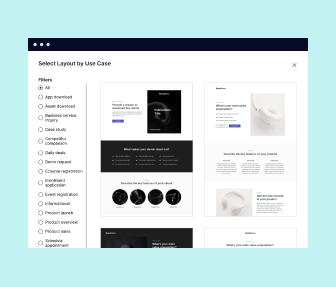
Multiple layouts for any industry and goal
Select from 500+ landing page layouts built to boost conversions across industry-specific scenarios. Customize them by adjusting fonts, adding images, and generating on-brand content with the AI assistant. Quickly scale with Instablocks® and Global Blocks that you can save, reuse, and update globally.
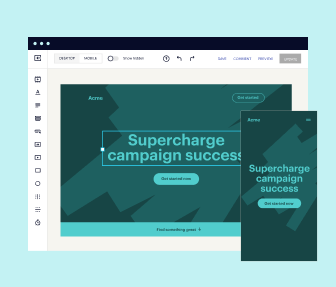
Loads fast and looks polished on any device
Every template is responsive, which means they present professionally on any device and load blazingly fast with our Thor Render Engine. You can also power them up with Google AMP technology to deliver an unparalleled mobile experience and drive higher conversions.
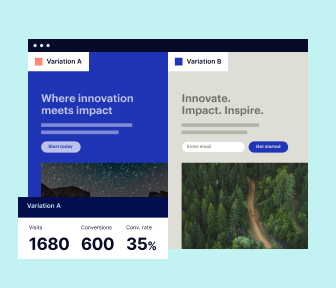
Robust analytics & experimentation
Get real-time updates and reporting across all your devices, showing the number of visitors, conversions, cost-per-visitor, and cost-per-lead. Launch AI-powered experiments, run A/B tests, and use heatmaps to analyze user behavior, then optimize your landing page to maximize conversions.
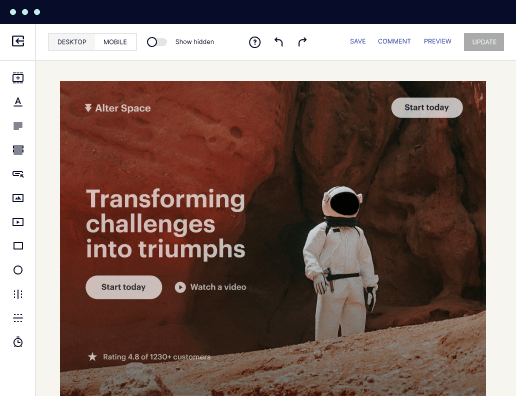
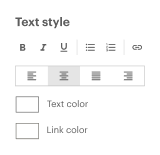
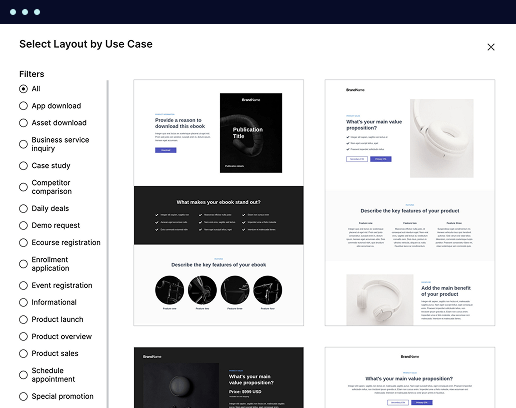
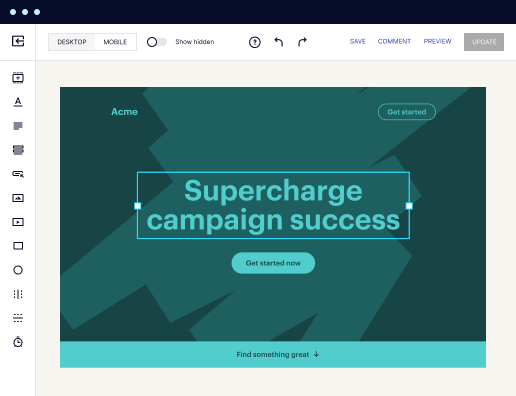

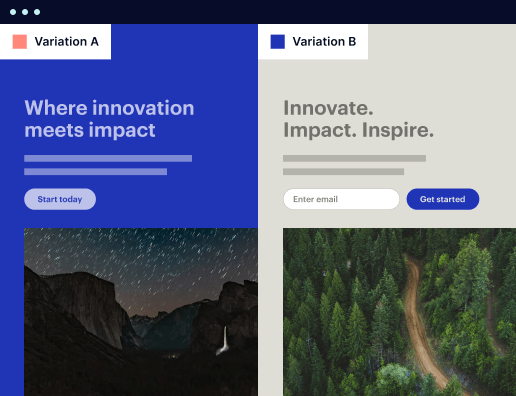
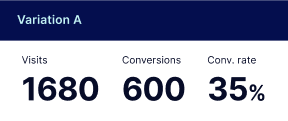
Easy to build without coding
With the intuitive drag-and-drop builder, anyone on your team can create high-converting pages without any knowledge of code or design. Make enhancements to your landing page with custom widgets using Javascript, HTML/CSS, or third-party scripts.
Multiple layouts for any industry and goal
Select from 500+ landing page layouts built to boost conversions across industry-specific scenarios. Customize them by adjusting fonts, adding images, and generating on-brand content with the AI assistant. Quickly scale with Instablocks® and Global Blocks that you can save, reuse, and update globally.
Loads fast and looks polished on any device
Every template is responsive, which means they present professionally on any device and load blazingly fast with our Thor Render Engine.
Robust analytics & experimentation
Get real-time updates and reporting across all your devices, showing the number of visitors, conversions, cost-per-visitor, and cost-per-lead. Launch AI-powered experiments, run A/B tests, and use heatmaps to analyze user behavior, then optimize your landing page to maximize conversions.
All the features you need to build lead-generating landing pages
Explore more featuresLearn how to build top-performing landing pages for any goal
FAQs
Leading the way in building high-performing landing pages





A step-by-step guide to optimizing digital campaigns with Instapage
To achieve unparalleled results in digital marketing, leveraging Instapage's powerful landing page and conversion rate optimization (CRO) platform is essential. This guide will walk you through the process of utilizing these tools to optimize your marketing campaigns effectively.
Understanding the power of Instapage
Instapage offers an all-in-one solution for marketers looking to boost their ROI. Its user-friendly interface allows you to harness advanced features that enable swift and efficient campaign optimization. With access to 100+ high-converting templates tailored for various industries such as business services, tech/SaaS, and financial services, creating landing pages has never been easier.
- Diverse template library: Choose from professionally designed templates tailored to specific verticals, perfect for attracting and converting leads.
- Inbuilt lead generation tools: Integrated elements that enhance the lead capture process directly boost your conversion rates.
- Real-time collaboration: Work seamlessly with your team and stakeholders, allowing for instant feedback and efficient page edits.
Step 1: Crafting your landing page
Creating a successful landing page is the first crucial step in maximizing your digital marketing efforts. Focus on clear messaging and a conversion-oriented design that resonates with your audience.
Step 2: Optimizing with A/B testing
Implementing A/B tests enables constant refinement of your landing pages.
- Test headlines: Experiment with different headlines to see which garners the most attention.
- Evaluate CTAs: Changing call to action buttons can drastically impact conversion rates. A/B testing allows you to find the most effective wording or position.
- Analyze page layouts: Test various layouts to identify which arrangement offers the highest visitor engagement.
Step 3: Utilizing personalization techniques
Personalizing your landing pages enhances user experience and boosts conversions.
- Dynamic text replacement: Tailor the content based on user interactions with previous ads for a seamless experience.
- AdMaps: Match your ads to landing pages effectively ensuring coherent messaging, which increases trusted communication.
- Audience-level tracking: Use Instapage's data tools to analyze performance metrics tailored to specific audience segments.
By implementing the above strategies, you'll create high-performing landing pages that drive results and significantly improve marketing outcomes. Optimize continuously to keep pace with your audience's needs.
Ready to supercharge your marketing campaigns? Start using Instapage today to create stunning, optimized landing pages that convert!
HTML page template for cloud computing companies
The essential structure of HTML page templates for cloud computing companies
HTML page templates serve as reliable starting points for building websites, especially for cloud computing companies. They provide a framework that can be customized to fit specific branding and functional needs, making it easier for businesses to establish their online presence quickly. The purpose of these templates is to streamline web development processes while ensuring uniformity across web pages. For cloud computing companies, having an effective HTML page template is crucial as it reflects their commitment to innovation and modernity.
In the rapidly evolving cloud computing landscape, a well-designed HTML template isn’t just an aesthetic choice. It holds significant importance for a company's branding and marketing efforts. A cohesive design enhances user experience and strengthens the company's credibility in the marketplace. Furthermore, a template that embraces best practices in web development can improve search engine rankings, thereby attracting more traffic.
Responsive Design: Ensures optimal viewing experience across various devices.
Fast Load Times: Crucial for retaining visitors and decreasing bounce rates.
SEO Optimization Capabilities: Essential for attracting organic traffic and improving visibility.
Crafting a user-centric experience
Understanding the target audience is pivotal for cloud computing companies aiming to create effective HTML templates. By identifying potential users, such as tech companies, startups, and established enterprises, businesses can tailor their web presence to meet specific needs. Recognizing user behavior and preferences allows template creators to implement features that enhance user engagement, ensuring visitors find what they're looking for effortlessly.
Design elements play a significant role in attracting and retaining users on cloud computing websites. Utilizing color theory based on the company’s branding can establish a sense of trust and familiarity. Moreover, thoughtful typography enhances readability, helping visitors absorb information quickly. Visual hierarchy is equally important as it guides users’ attention, making critical information easily accessible.
Use of color theory and branding to create visual connections with audiences.
Typography choices that ensure clarity and impactful messaging.
Effective visual hierarchy to guide user journey through content.
Functionality as the cornerstone of template design
Functionality is key when designing HTML templates for cloud computing companies. Leveraging JavaScript not only enhances user experience but also allows for the creation of dynamic content. JavaScript functions can facilitate event-driven programming, making web pages more interactive. This engagement is vital as it keeps users interested and encourages them to explore further.
An effective use of `document.addEventListener` enhances real-time interactivity. This CSS feature allows web pages to respond to various user actions, such as clicks and form submissions, without requiring a full refresh. By listening for events, the template can provide seamless interactions, thus improving overall user experience.
Event-driven programming that enhances interactivity.
Modular JavaScript code that supports enhanced functionality.
Listening for events to improve real-time interactivity.
Optimizing for performance and usability
Load speed is a critical factor in web design, especially for cloud computing companies where users expect immediate access to information. A slow website can drive potential clients away, so employing best practices aimed at minimal latency is vital. Techniques like image optimization, asynchronous loading of scripts, and minimizing HTTP requests can all contribute to a faster loading experience.
User retention is highly dependent on performance. If a user's experience is hindered by slow load times, they tend to abandon the site, increasing bounce rates. Thus, regular performance assessments should be made to ensure that any potential issues are addressed promptly, preserving user engagement.
Implementing image optimization for reduced load times.
Using asynchronous loading of scripts to improve speed.
Regular performance assessments to maintain user engagement.
The technical backbone: DOM and load events
Understanding the Document Object Model (DOM) is crucial for the effective design of HTML templates. The DOM represents the structure of a web page and allows developers to interact with content dynamically. Familiarity with the roles and elements of the DOM enables template designers to create responsive web experiences, as they can manipulate content based on user actions seamlessly.
Utilizing the `DOMContentLoaded` event is vital for efficient loading practices. This event signals when the initial HTML document has been completely loaded and parsed, allowing for ready execution of scripts without needing to wait for all external resources to finish loading. This practice enhances template performance, ensuring that critical content is accessible to users as soon as possible.
Understanding the DOM enables dynamic interaction with web content.
Utilizing the DOMContentLoaded event for improved load times.
Enhancing performance through effective script management.
Template features for cloud computing escalation
Incorporating cloud-specific functionalities in HTML templates is essential for businesses that rely on cloud services. These include live data integration and APIs that provide real-time updates from cloud platforms. This ensures users are interacting with the most relevant data, fostering a connection between the service provider and clients.
Interactive dashboards are another critical aspect of cloud computing templates. These dashboards can display user feedback and analytics, allowing businesses to respond effectively to client needs. Security features tailored for cloud solutions should also be a priority, as the sensitive nature of data requires robust security measures. Implementing HTTPS and keeping abreast of best security practices are fundamental.
Live data integration from cloud services for real-time updates.
Interactive dashboards that display user feedback and analytics.
Implementing best security practices, including the use of HTTPS.
Integrating marketing tools into HTML templates
Tracking and analytics are integral to understanding how well a cloud computing company’s website is performing. Implementing tools like Google Analytics within templates can provide insights into user behavior, allowing businesses to adapt their strategies accordingly. This data, when incorporated correctly into the HTML structure, enhances the overall effectiveness of marketing efforts.
Lead generation mechanisms like forms and pop-ups are effective strategies for converting visitors into potential clients. Ensuring clear call-to-action elements are present encourages users to engage with the company further. A/B testing various template elements allows for the optimization of conversion rates while maintaining a user-friendly experience.
Implementing Google Analytics for user behavior insights.
Using effective forms and pop-ups for lead generation.
A/B testing for enhancing conversion rates and user experience.
Future trends in HTML template development for cloud companies
As technology advances, HTML templates for cloud computing companies are set to evolve significantly. The integration of artificial intelligence and machine learning can provide more personalized user experiences. This shift means templates will need to incorporate AI-driven features that enhance interaction and decision-making for users as they navigate a company's offerings.
API integrations are also crucial for real-time data usage, allowing cloud companies to maintain up-to-date user information directly on their web pages. The potential rise of progressive web apps (PWAs) is expected to redefine how templates are built, promoting faster interactions and offline capabilities. Additionally, the advent of low-code and no-code platforms could democratize template development, enabling those without extensive coding skills to design effective sites.
Integration of AI and machine learning for personalized user experiences.
API integrations for real-time data usage across cloud services.
The rise of PWAs and low-code/no-code platforms in template development.
Case studies and real-world applications
Examining real-world applications of cloud-centric templates offers valuable insights into effective design. Startups, for instance, have successfully utilized well-structured landing pages to capture leads and build brand awareness quickly. These companies often combine aesthetically pleasing design with strategic user flow that guides visitors toward conversion points, showcasing the practical benefits of tailored templates.
Conversely, established companies can enhance their online presence by updating their HTML templates to better reflect modern design trends and user expectations. However, many fall into common pitfalls, such as overcrowded layouts or slow load times. Learning from these missteps leads to improvement strategies that focus on user feedback, making continuous evolution essential for success in competitive markets.
Successful landing pages developed by startups for capturing leads.
Establishing companies enhancing their online presence through modern design.
Learning from common design flaws to improve user satisfaction.
Summing up the value of customized HTML templates
In summary, customized HTML templates for cloud computing companies must encompass various essential features. From responsive design to optimized loading and security, these templates play a pivotal role in company success in the digital space. Their ability to adapt to user needs and respond to performance metrics significantly impacts user satisfaction and retention.
The long-term impact of investing in quality HTML templates can lead to substantial business growth and scalability. As the digital landscape continues to evolve, remaining adaptable and innovative will be key to staying competitive. Templates that align with emerging trends not only provide immediate benefits but also pave the way for future opportunities.
Essential features for cloud computing focus include speed, security, and user experience.
Investing in templates affects long-term growth and adaptability.
Importance of aligning templates with emerging trends for competitive advantage.
Ready to skyrocket conversions?
Supercharge your ad campaigns with high-performing landing pages
Get started